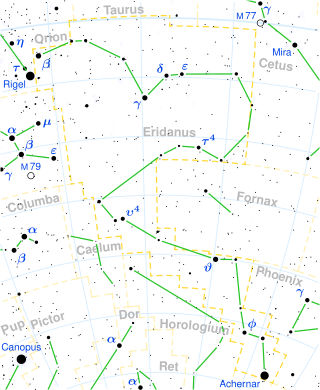Top Qs
Timeline
Chat
Perspective
Pi Ceti
Spectroscopic binary star system in the constellation Cetus From Wikipedia, the free encyclopedia
Remove ads
Pi Ceti, Latinized from π Ceti, is the Bayer designation for a star system in the equatorial constellation of Cetus. It is visible to the naked eye with an apparent visual magnitude of 4.238.[2] Observed to have an Earth half yearly parallax shift of 8.30 mas,[1] it is around 393 light years from the Sun.
This is a single-lined spectroscopic binary system with a nearly circular orbit and a period of 7.45 years. The fact that the system has a negligible eccentricity is surprising for such a long period, and may suggest that the secondary is a white dwarf that had its orbit circularized during a mass-transfer event.[6]
The primary, component A, is a normal B-type star[7] that has been given stellar classifications of B7 V[3] and B7 IV.[4] It appears very young – less than half a million years in age – and may still be on a pre-main sequence track. The star shows no magnetic field but it does emit an infrared excess.[7]
Remove ads
Name
This star, along with ε Cet, ρ Cet and σ Cet, was Al Sufi's Al Sadr al Ḳaiṭos, the Whale's breast/chest (upper torso).[10] Per Jack Rhoads's Reduced Star Catalog Containing 537 Named Stars, Al Sufi's numerically ordered stars (1 to 4), were ρ (rho), σ (sigma), ε (epsilon) and this star.[11]
In Chinese, 天苑 (Tiān Yuàn), meaning Celestial Meadows, refers to an asterism consisting of π Ceti, and 15 stars in Eridanus: γ, π, δ, ε, ζ, η, and the string of τ (Tau)1, 2, 3, 4, 5, 6, 7, 8 and 9. Consequently, the Chinese name for the star is 天苑七 (Tiān Yuàn qī) meaning Celestial Meadows: seven.[12]
Remove ads
References
Wikiwand - on
Seamless Wikipedia browsing. On steroids.
Remove ads

